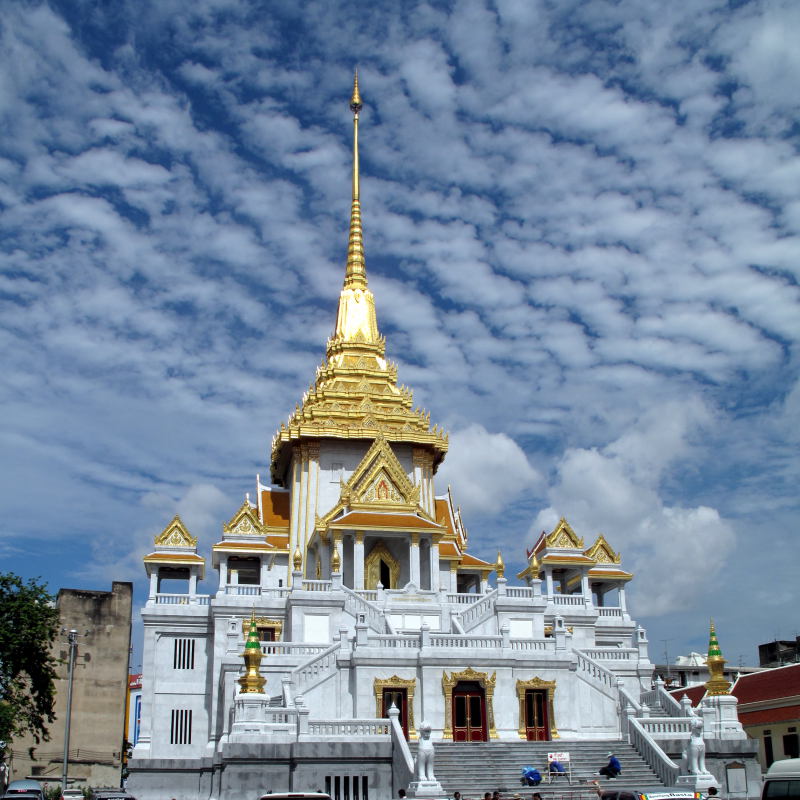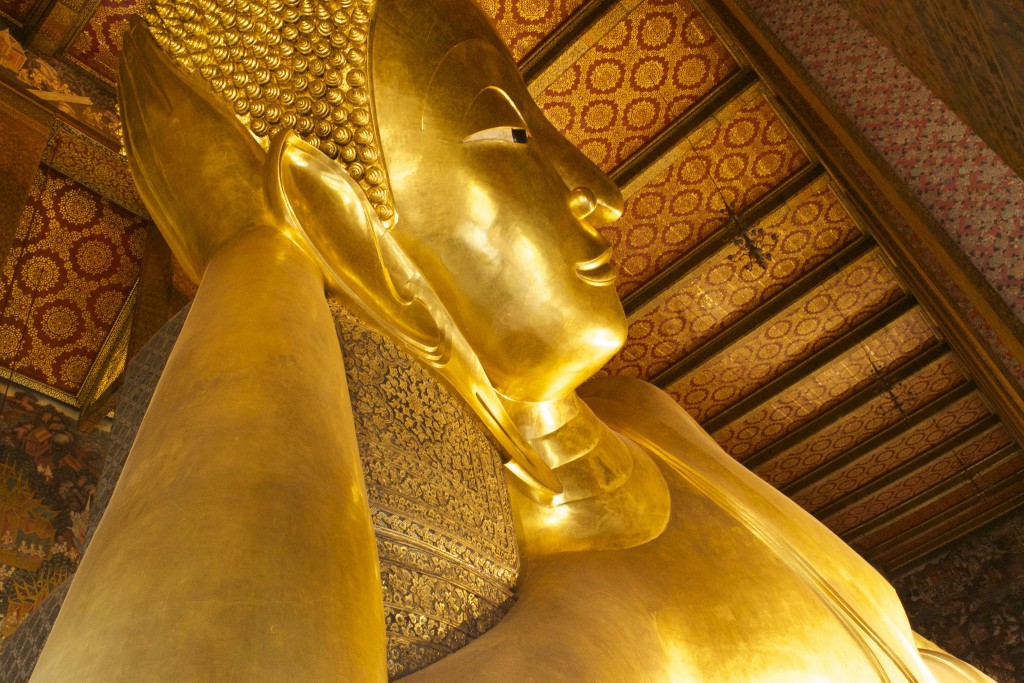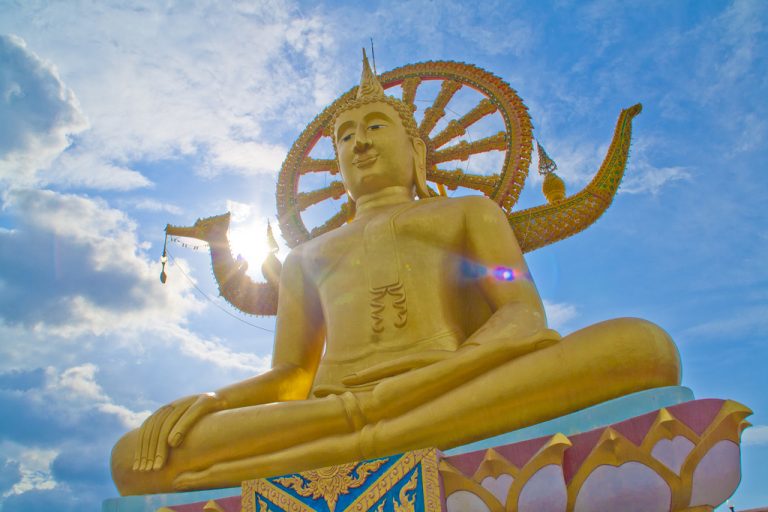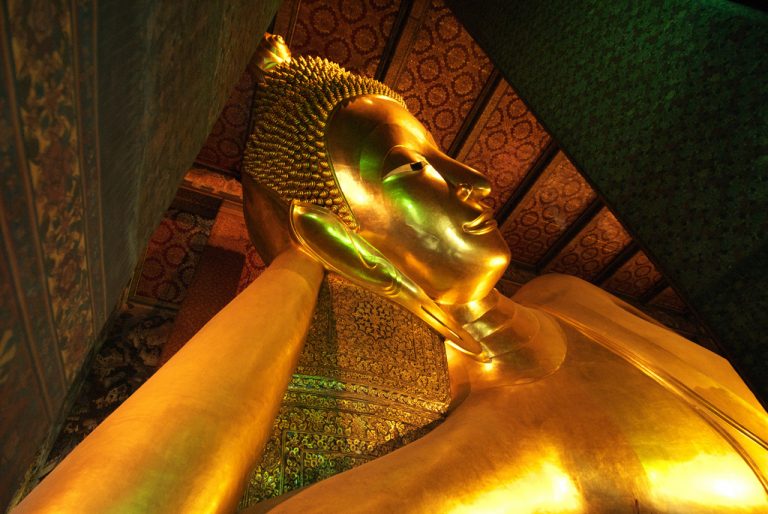The
Golden Buddha, officially titled Phra Phuttha Maha Suwana Patimakon is a
gold statue, with a weight of 5.5 tons (5,500 kilograms). It is located
in the temple of Wat Traimit, Bangkok, Thailand.Located at the end of
Chinatown's Yaowarat Road, near Hualampong Railway Station, Wat Traimit
houses the world's largest massive gold seated Buddha measuring nearly
five metres in height and weighing five and a half tons. In the past,
artisans crafted the Buddhas in gold and disguised them from invading
armies by a covering of stucco and plaster.At one end of Chinatown, in
what was once an otherwise unremarkable temple of Wat Traimit, sits the
world's largest solid gold Buddha image. Made of about 83% pure gold and
weighing in at five and a half tons, the 15-foot tall seated image is
worth millions of dollars at today's gold prices.The Buddha at Wat
Traimit was discovered by accident when it was accidentally dropped as
it was being moved, revealing, under a casing of plaster, a beautiful
solid gold Sukhothai style Buddha. Pieces of the plaster are still kept
on display.This temple is well known for its 3-metre tall, 5.5 tons
solid gold Buddha image, constructed over 700 years ago during the
Sukhothai period. Originally the gold image was covered with plaster to
conceal it from the invading Burmese and was just rediscovered
accidentally about 40 years ago.

On 14 February 2010, Wat Traimit’s new building named “Phra Maha Mondop” was officially opened to the public. And the Gold Buddha was moved here. The first floor of the building is the Yaowarat Chinatown Heritage Centre where tourists can learn the history of the Chinese immigrants in Thailand as well as their culture which has become part of the Thai culture. The second floor holds an exhibition of the origin of the Gold Buddha. And the top level is where the world’s largest gold Buddha image is enshrined. The image has a colorful history, which is recounted in a free pamphlet distributed with your paid admission.The Golden Buddha was cast sometime in the 13th century and is an excellent example of the gracious Sukhothai style that is still very much in favor to this day. At some point, it was covered in plaster and lacquer, most likely in an attempt to hide the valuable icon from thieves or looters.
The disguise was so good that everyone apparently forgot about what was hidden beneath. A member of King Rama III's court had the statue moved to Bangkok and installed in a temple near where the Oriental Hotel is today. That temple fell into disuse and was completely abandoned around 1931.The true nature of the Golden Buddha wasn't discovered until it was moved to its present location at Wat Traimit in 1955. When the image was being hoisted into its new home, the ropes broke, dropping the statue. Some of the plaster was chipped off, revealing the gold underneath. Bits of the plaster are on display in the interpretive center below the chapel.The statue now sits in a new (opened in early 2010) chapel perched high atop a four story marble-clad ziggurat. The second and third floors of the structure house an interpretive center. The second floor exhibits cover the history of the Chinese community in Bangkok, starting with a 3D presentation and moving on through slice-of-life scenes of Chinese traders in years gone by.

The third floor museum covers the history of the Golden Buddha image itself. The video presentation at the beginning provides a good brief background on Buddha images in general, as well as the full story of the "subduing Mara" pose for this image. The exhibits cover how the image was made as well as the historical background of how it came to be at Wat Traimit.
History of the Golden Buddha at Wat Traimit:-Named Phra Sukhothai Traimit, this statue is placed in Wat Traimit near Chinatown in Bangkok. In the traditional sitting poster, it measures 3.10 m. across the lap from knee to knee and 3.91m. from base to top. A peculiarity of the statue is that it can be taken to 9 pieces. The purity of gold is 40 % from the base up to the neck, 80 % from the chin to the forehead, and 99 % for the hair and the topknot, weighing 45 kg. It was estimated that the gold Buddha was built in the Sukhothai period (1238-1438). But there are no written records of its origin.Towards the end of the 18th century after King Rama I estabished Bangkok as the new capital, he ordered the removal of all important Buddha images from the North to Bangkok lest they might suffer damage since the northern region was not yet pacified. And among the statues moved to Bangkok was this gold Buddha. But it was covered with stucco and placed at Wat Phraya Krai without arousing any special interest among the worshippers.Later, Wat Phraya Krai became dilapidated and was ordered closed by King Rama V(1868-1910). And this statue was moved to Wat Traimit. The abbot of the temple then asked other monasteries for a possible transfer. But nobody was interested because of its huge size and plain look. So the abbot decided to keep the statue in his own temple and built a special vihara to house it.

On the eve of its scheduled removal, a heavy rain soaked the stucco covering. In the act of moving, the statue was accidentally dropped and the stucco cracked, revealing the shining gold inside.The origins of this statue are uncertain. It is made in the Sukhothai Dynasty style of the 13th-14th centuries, though it could have been made after that time. The head of the statue is egg-shaped, which indicates its origin in the Sukothai period. Given that Sukothai art had Indian influences and metal figures of the Buddha made in India used to be taken to various countries for installation, this suggests the Golden Buddha statue may have been cast in parts in India.Some scholars believe the statue is mentioned in the somewhat controversial Ram Khamhaeng stele. In lines 23-27 of the first stone slab of the stele, "a gold Buddha image" is mentioned as being located "in the middle of Sukhothai City," interpreted as being a reference to the Wat Traimit Golden Buddha.
At some point, the statue was completely plastered over to prevent it from being stolen. The statue was covered with a thick layer of stucco, which was painted and inlaid with bits of coloured glass.It is believed that this plastering over took place before the destruction of Ayutthaya kingdom by Burmese invaders in 1767. The statue remained among the ruins of Ayutthaya without attracting much attention.In 1801, Thai King Buddha Yodfa Chulaloke (Rama I), after establishing Bangkok as a new capital city of the Kingdom, and after commissioning the construction of many temples in Bangkok, ordered that various old Buddha images should be brought to Bangkok from the ruined temples around the country.At the time of King Rama III (1824-1851), the statue, still covered with stucco, was installed as the principal Buddha image in the main temple building of Wat Chotanaram in Bangkok.

When Wat Chotanaram, located near Chinatown, fell into disrepair and was closed, the statue was moved to its present location at the nearby Wat Traimit in 1935.[4] At the time, Wat Traimit was a pagoda of minor significance (like hundreds of other Buddhist temples that exist in Bangkok). Since the temple didn't have a building big enough to house the statue, it was kept for 20 years under a simple tin roof. The true identity of this statue had been forgotten for almost 200 years.
Discovery of the golden statue:-In 1954, a new Viharn building was built at the temple to house the statue. It was being moved to its new location on 25 May 1955 and there are a variety of accounts of what exactly happened next, but it is clear that during the final attempt to lift the statue from its pedestal, the ropes broke, and the statue fell hard on the ground. At that moment, some of the plaster coating chipped off, allowing the gold surface underneath to be seen. Work was immediately stopped so that an evaluation could be made.All the plaster was carefully removed and during the process, photos were taken, and are now displayed in the Temple for visitors. Pieces of the actual plaster are also on public display. When all the plaster was removed, it was found that the gold statue actually consisted of nine parts that fit smoothly together. A key was also found encased in plaster at its base, which can be used to disassemble the statue, allowing for easier transportation.The golden statue was discovered very close to the commemoration of the twenty-fifth Buddhist Era (2500 years since Gautama Buddha's passing) so the Thai news media was full of reports and many Buddhists regarded the occurrence as miraculous.On 14 February 2010, a large new building was inaugurated at the Wat Traimit Temple to house the Gold Buddha. The building also contains the Bangkok Chinatown Heritage Centre, and an exhibition on the origin of the Gold Buddha.
No comments:
Post a Comment